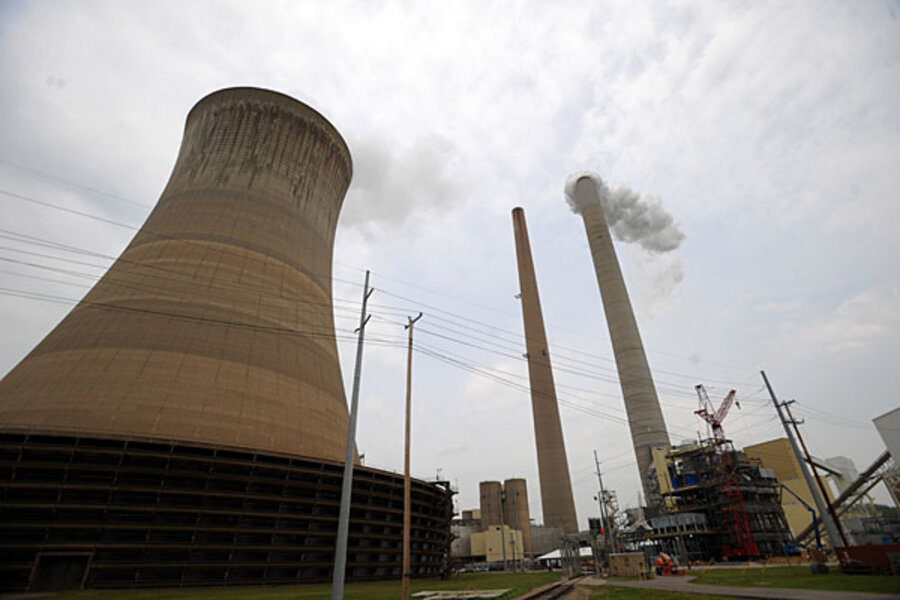Carbon dioxide super-scrubber? Potential good news in global warming fight.
Loading...
Using cheap, readily available materials, a team of chemists has developed a new compound for drawing carbon dioxide out of the atmosphere.
The compound holds the potential to drive down the cost of capturing carbon, although it's too early to say by how much, the scientists say.
The results "add to the list of possible materials that can absorb CO2 from the air, and it potentially could be quite a good one," says Klaus Lackner, who heads the department of earth and environmental engineering at Columbia University in New York and was not part of the team formulating the material.
Capturing carbon represents one approach to combating human-triggered global warming, which most climate scientists attribute in some degree to increases in atmospheric carbon dioxide from industrial activity as well as to carbon dioxide released through land-use changes.
Aside from the relatively low cost of the materials needed to make the new CO2 sponge, the compound can absorb significant amounts of CO2. It can endure several cycles of absorbing and releasing the gas for sequestration or recycling. And the energy needed to release the gas is low compared with many current materials.
"It has some nice qualities," Dr. Lackner says of the material, although he adds that it remains to be seen how practical the material could be.
But carbon capture is a controversial approach.
Critics argue that, at least with current technologies, carbon capture is too expensive, compared with approaches to prevent the CO2 emissions in the first place. They says its deployment could needlessly delay the process of weaning economies from fossil fuels – the dominant source of global CO2 emissions.
In addition, once the carbon dioxide is scrubbed – either at the smokestack or from the air itself – storing it for hundreds to thousands of years to keep it out of the atmosphere brings its own set of environmental concerns.
Still, advocates counter that some form of carbon capture and storage (or recycling) ultimately will be needed to counter global warming. Economies continue to pump CO2 into the atmosphere at a significant pace. Each fresh molecule of CO2 that isn't absorbed by the oceans or by terrestrial plants will remain in the atmosphere for hundreds of years, greasing the skids for additional warming.
They add that research in to carbon capture and sequestration currently focuses largely on big, individual sources of CO2 emissions, such as power plants. That leaves highly dispersed sources – cars, aircraft, and homes, for instance – to continue emitting.
Thus, advocates argue, air capture will be an indispensable tool for snagging CO2 from these more-diffuse sources. And over long periods of time, the approach could, in principle, scrub CO2 from the atmosphere, moving global average temperatures to more-politically acceptable levels.
For its part, the team developing the new material for air capture is motivated by a desire to use the CO2 it recovers as much as it is by a desire to combat global warming, notes Surya Prakash, director of the University of Southern California's Lokar Hydrocarbon Research Institute and one of the researchers involved in the effort.
"Our interest is not just to capture and get rid of it" he says of CO2, "but we want to use it and recycle it."
In particular, the team is working on ways to incorporate scrubbed CO2 into the production of methanol, which the team envisions as a replacement for oil and gas in making plastics, fertilizers, and other products that include fossil fuels in their recipes.
To develop the new CO2-absorbing material, the team dissolved a polyethylene-like plastic in methanol and blended it with another mixture of methanol and what in essence is fine-grained sand. After the blend mixed thoroughly, the team heated the mixture to remove the liquid solvent. What remained was a white solid.
It absorbs CO2 at room temperature and releases it at around 185 degrees Fahrenheit. Compared with many materials, that's a narrow span of temperatures, implying less energy needed for a scrubbing system to work. Indeed, the material could run on waste heat from other industrial processes, Dr. Prakash says.
Moreover the material works well whether the air passing over it is dry or humid.
Although large-scale air capture of CO2 is still a ways off, the approach could be used more immediately in niche applications, Prakash says.
Among them: Scrubbing CO2 from the air in submarines or spacecraft, or maintaining a CO2-free environment for certain types of fuel cells or for large storage batteries under development.







